Aesthetic Grounds: August 2007 Archives
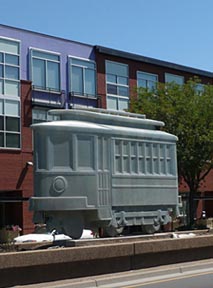 This summer, Lawrence Argent installed "Ghost Trolley" in Aurora, Colorado, at a moment when rebirth of trolley systems or "light rail" has achieved messianic proportions throughout the USA. After nearly 100 years of automobiles, light rail is the mass transit system of choice for the suburban middle class moving back to the city centers. All planners under 40 years old assume that the renovated American cities of the future will be organized around light rail stations with heavy rail linking cities within metropolitan regions. All this environmentally intelligent dreaming (or "smart growth") is currently tiny compared to the expanding automotive sprawl and the coming re-investment in broken bridges and cracking concrete pavement.
This summer, Lawrence Argent installed "Ghost Trolley" in Aurora, Colorado, at a moment when rebirth of trolley systems or "light rail" has achieved messianic proportions throughout the USA. After nearly 100 years of automobiles, light rail is the mass transit system of choice for the suburban middle class moving back to the city centers. All planners under 40 years old assume that the renovated American cities of the future will be organized around light rail stations with heavy rail linking cities within metropolitan regions. All this environmentally intelligent dreaming (or "smart growth") is currently tiny compared to the expanding automotive sprawl and the coming re-investment in broken bridges and cracking concrete pavement.
As is now epic myth, General Motors bought the Los Angeles trolley companies, dismantled the tracks, substituted bus lines and lobbied for highways. It's not that evil. American mass production and higher wages made the automobiles relatively affordable and matched the American passion for individual freedom of mobility. The trolley lines' profitability was dependent on the crowded and aging tenements, rowhouses and apartments. Only the landlord would avoid the fresh air of the suburbs and convertible.
In line with the rest of the nation, the last trolley to Aurora rolled in 1932 on the tracks underneath the site of the "Ghost Trolley". In Denver, the streetcar system began in 1883 and was in full operation by 1900 through out the Denver. Aurora hopes the Denver metro's light rail system will pull into its downtown before 2020.
Argent and the Aurora Public Art Program must be fully aware of the moment, although I do not know - or care in regards to this essay - their political or conceptual involvement. What matters to critical assessment of public art is the existence of the moment and the artist's AND the agency's action within this moment. Without engagement of the moment, the artwork become "art in public places", not public art. This is lengthy discussion that does not degrade "art in public places", but just strives to clarify a critical attribute that is frequently dodged, ignored and generally hoped will disappear by sponsoring agencies. Worse, than providing disliked artwork, might be artwork with an ambiguous message that speaks to an obvious or ignored cultural transformation. (Since the cultural wars of the 1980s, direct negative commentary or sexual messages have been censored by funding agencies.)
In our artistic tradition, significant public artworks (and private ones) are associated with the moment: i.e. the Statue of Liberty with the hope of European immigrants. As the moment sinks from significance, so can the artwork.
To determine the value in the moment let's use Kenneth Frampton's comparative method. Matthew Dehaemers's 2003 "Point of Departureflying streetcar in Kansas City seeks a similar function in the same civic moment as Argent's "Ghost Trolley" in metro Denver. (Argent tells me he never saw Dehaemer's temporary project. But this is irrelevant to my assessment of either work in this age of vernacular art.) Kansas City was in a decade long fight between a citizen activist for light rail and the city's establishment that was resolved in November 2006 when a sales tax increases was passed by the voters without City support.
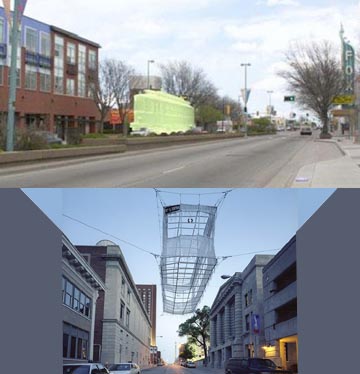
Argent's Ghost Trolly, '07 and Matthew Dehaemers' Point of Departure, '03
What is the same?
Real scale of an early 20th century trolley
Located in the center of the street like a trolley
Uses "white" to suggest the spirit attribute
No illusion of motion. Static fact.
Made when light rail was under discussion in both cities
What is different?
Ghost Trolley......Point of Departure
Frosted composite materials......Net of cotton cords
On the ground in the median......Suspended over the street
Flattened axonometric image ......Dramatic lines in perspective
Solid......Transparent
Industrially carved......Handmade like a grandmother's shawl
Light rail under construction......Light rail rejected by voters
Both works are factual without any real interpretation. They declare merely "trolleys were here". Dehaemer's handmade quality with the antique fringe and its flying position is more evocative of an actual ghost. Argent bets on the clever 3-D illusion.

Karl Yoder Mural in Philly and Typical Tourist Trolley Today
The question for me is why both artists chose the historic trolley instead of the Buck Roger's streamline or the Japanese bullet train. The historic trolley has been degraded by its overuse as the standard warm weather tourist transport in every American city. Where is the connection to Tennessee Williams "A Streetcar Named Desire" so easily referenced by Mona Caron in her 1998 mural? Where are the thousand filmic chase scenes with people jumping on and off the trolleys? Especially the "Streets of San Francisco"? If the image is historic, then a connection Charlie Chaplin or Buster Keaton? Where is the energy of the train in Kansas City's Thomas Hart Benton paintings and prints of the 1930 or 40s? Or his reality of the workingman's life that used and serviced the trolley. Where is GM or its equivalent?
Brando still from Street Car Named Desire and Mona Caron "Desire" train mural (photo Eric Haas)
Why are public artist getting away with only the facts? I might say that agencies are afraid of the interpretations, but the fact object is a dominant historic trend of 50 years of art at least since Jasper John's target and flag and Oldenburg's baseball bat. Beyond the oversized element (to be discussed in the next Argent essay), the fact object confronts the audience with the value of that common thing or situation so frequently overlooked. The confrontation requires surprise at the object selected and the location displayed. Both Argent and Dehaemer fail to surprise us as the moment expected the rebirth of trolley in exactly those places.
Trolley in House in 1952 and Abandoned in 2006
In Aurora while Argent was fabricating "Ghost Trolley", an amazing event occurred and then disappeared. A hundred year old trolley was re-discovered boarded-up suburban house. In 1950, Edwin Perrott bought a trolley for $50 and built a house around it, converting the interior to a sitting room and bedroom. A classic American tale of reuse and invention on private property in the Western USA where ABSOLUTELY NO ONE or THE GOVERNMENT had the right to tell YOU WHAT TO DO. In 2006, as Sgt. Franklin Michelson inspected the abandoned house, he found and informed the City of the trolley in the house. Within a few months, the Historic Society had raised the money to move the trolley from the house with a pledge to restore the trolley. For reasons of failed imagination, the restored trolley - another fact - was more important that the complex story and imaginative potential of the trolley in the house. Truly a "spirit" that speaks to the cultural abandonment of the mass transit and the trolley's reincarnation at the heart of the suburban freedom served by the automobile.
JUST TO KEEP THINKING
Both Argent and Dehaemers have created works with comparible attributes to other contemporary artists - most likely without awareness of the other artist. Again, who cares that the techique has been used, but rather how has the techique been modified for the situation? Does the use of the technique enhance the message of the artists and its moment?
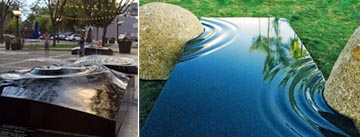
Argent's "Confluence", 2006, Fort Collins, CO, USA and Hew Chee Fong/L.M.Noonan's "Stillwater + Rocksack", 1999, Carindale, QLD, Australia
Argent's "Confluence", 2006
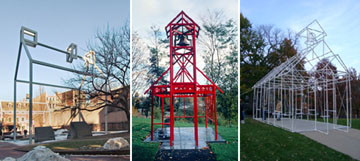
Venturi in Philly - Jenson in SeaTac, WA - Dehaemers in Kansas City
UPDATE OF SORTS: See Discussion with Ries in the Comments
Seattle Art Musuem Olympic Sculpture Park, where Mark Dion did a piece about a Nurse Log ("Neukom Vivarium, 2007"), and many people brought up Buster Simpson's Nurse Log ("Host Analog", 1991) of ten years or so before, in Portland. General consensus was the subject had enough inherent interest to attract two different artists, at two different times, and no copying, or, in fact, even awareness of the other, had occurred. From Ries.
Buster Simpson, Host Analog, 1991, Oregon Convention Center, Portland, Oregon
Mark Dion, Neukom Vivarium, 2007, Olympic Sculpture Park, Seattle, Washington
In 1991, Buster Simpson planted Douglas Fir, Hemlock, and Western Red Cedar seeds onto an eighty-foot-long Douglas Fir nurse log.
In 2007, Mark Dion's work features a 60-foot decaying "nurse log" enclosed in a greenhouse. Cycles of decay and renewal will be evident to current and future generations of park visitors, who can observe the thriving bacteria, fungi, lichen, plants and insects with microscopes and artist-designed field guides.
FINAL COMMENT
Because Buster Simpson is a lifelong member of the Seattle community and one of the American founders of public art, I find it insulting that Dion was permitted to make and exhibit this work in such a high profile situation. The Seattle Art Museum should have told Dion - we are sorry, but we would like a different work of art. Artisticly, I think it is great to have two similar works, but socially, another local Art Museum with international ambitions slaps the local artist in the face. Excuse me, but it just sucks.
Digg it....... Save to Del.icio.us ....... Save to Technorati
40th Anniversity of Blake's Sargent Pepper Album cover for the Beattles
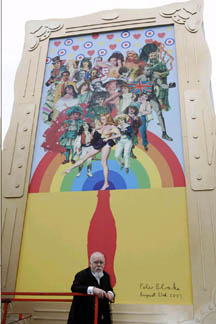
Public Art managers and curators have developed successful collaborations with community-based organizations to enhance the value and participation of a new artwork, but in general the industry has failed to capture potential coordination via the mass media and Internet. In London last week, Coca Cola gave the public art establishment a lesson. Although Coca Cola was using this system to increase sales, nothing about the interactive system is ethically problematic. In fact, the system is an excellent example for building connection to works of art.
Coca Cola built a very user friendly website through which the average Internet user can make their own Coca Cola poster. The site was fun for me as it was very easy and fast to add images and to manipulate. The image base is constructed from Pop Iconography.
Coca Cola then hired Sir Peter Blake - one godfather of British Pop Art - to make a giant poster at a weeklong festival in London. Blake himself was at the installation as the contractor applied giant cutout figures, repeating Blake's own art making method known best through his 1967 Beatle's album cover. BCC and all media outlets provided extensive coverage due to Blake's participation and the Coca Cola PR machine.
Occasionally, artists themselves create the Internet participation and more frequently media attention through actions like hundreds of naked people in the streets. Sometimes around Olympics or the Superbowl, agencies have better coordination with the mass media. But I don't know of any successful projects like the Coca Cola Posters to foster wide participation and interest. PLEASE SEND ME EXAMPLES!!!
Generally, public art agencies do not start with question - "What kind of project can we invent to attract the media and wide participation in art making?" or "How can a future public art project help build support and awareness from a broad public?"
To watch the Channel 4 report and interview with Peter Blake, visit Channel 4 and click on "Watch the Report".
Visit the coca-cola.com website and click on the Coca Cola Creator.
Examples on Display
ALSO FROM THE UK
Artist, Tracey Emin writes a column for the Indepentent. She brings her "artwork as my life" to the general public. In 2005, she installed the world's most expensive public artwork per cubic inch - about $1,500. (75 cubic inches for $120,000 at today's exchange rate.) The work is smart. She questioned the issues of "size" versus intimate attention and placement. "It ain't the meat, it's the motion." She questioned the giant Liver Bird and its repetitive use a civic symbol in Liverpool through the tiny sparrow. Once you see the sparrow, you see the carelessness of the Liver Bird images. (For the record, I maintain a special place of affection in my heart for the artist that is a public pain-in-the-ass.
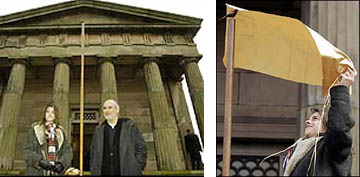
From the BBC Press Release: Artist Tracey Emin has unveiled her first piece of public art in Liverpool on Thursday. The Roman Standard - which features a small bird on top of a four-metre high bronze pole - is a tribute to the city's famous symbol the Liver Bird.
The sculpture was commissioned by the BBC as part of their contribution to the art05 festival and Liverpool's year as European Capital of Culture in 2008. It stands outside The Oratory, in Upper Duke Street by the Anglican Cathedral. Emin said the sculpture represents strength and femininity. The bird, which is the size of a sparrow, disappears when viewed from the front and only reappears as the viewer moves left to right.
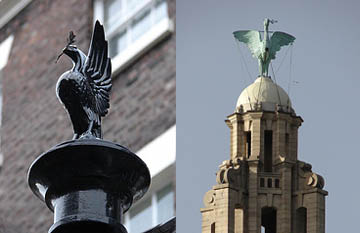
The Liver Bird of Liverpool
A detour from new critical methods development to respond to Flyover. Or maybe this is on the way.
Unlike the museum or journal, the players in the selection, design and implementation of public art and public space do not have the luxury of open exploration as the primary value. Everyone that has served on a diverse, but sophisticated design competition jury, knows that generally the museum-type artistic merit is most evident in the runner-up or second runner-up. The winner must satisfy a higher percentage of different values and attributes.
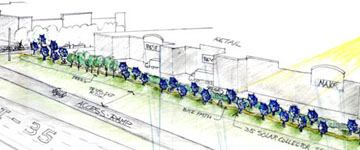
Harries & Heder Drawing for Sunflower, 2006.
As a recent example from Austin, Texas, Harries & Heder won the Catellus Development Group's competition for public art in front of a new suburban shopping strip center on Interstate 35. They were the correct winner, but The Art Guys envisioned the better public artwork. Harries & Heder project, to be completed later in 2007, is a rambling linear sequence of smaller shadetree-sized flowers with pedals of solar collectors. The work is less technically complex than Joaquin Fargas's Sunflower and less joyfully big toy than Marko Lehanka's Munster '07 flower sculpture. If the giant sunflowers where real trees on a bike path, then no one would even notice any formal composition. But as a double row of blue metallic structures, the bike ride might be invigorating event.
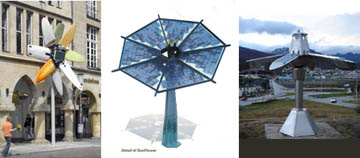
Lehanka - Harries & Heder - Fargas
Historically, Harries & Heder 14 foot diameter "Sunflowers" requires homage to Christo's 1991 Project "The Umbrellas" in Japan and California (with a nod to Martha Schwartz's Flying Saucer Garden, '98). The Umbrellas and the Gates are Christo's only projects of repeating forms at a human scale. At a distance, the huge 26-foot diameter blue umbrellas accentuated the terrain while creating a beautiful pattern of blue dots. When under to the umbrellas, a ceiling of blue spread out, or with less umbrellas a sequence of places arose. "Sunflowers" doesn't enhance nor embrace a landscape like Christo.
Umbrellas, 1991 (Christo) and Sunflowers, 2006 (Harries & Heder)
According to the artists, the work will be an "Icon for Sustainable Development" and will earn back 30% of its original cost through sold kilowatts. Here in lays the multiple values of public art. Harries & Heder's persuades by the symbol of sustainability - the same way that past public artist carved the "White Man defeating the Indian" or the "Determined Spirit of the American Farmer". The symbolic relationship between the sunflower, the sun and the high-tech disk combines with the functional attributes of shade for cyclists and distraction of driver's eyes from the delivery trucks behind. Harries & Heder won because diversity of values - societal, functional and visual. These are the heart of judgment for public art and public space.
But Sunflowers fails deliver a fresh re-making of Christo's legacy or an inventive synthesis that sparks my imagination to other things. I just think solar power in blue.
The Art Guys, Austin, 2006
According to one source, The Art Guys were the runner-up amoung other finalists Mel Ziegler and Dixie Friend Gay. The guys proposed playful figures of suburbanites on the top of a sequence of standard highway light poles. The figures are less universal than Jonathan Borofsky's Walking to the Sky series and more static than Chris Doyle's Leap.
The Art Guys, 2006 and Borofsky, 2004
Learning from the highway Texaco star or Shell seashell, the Arts Guy want a skyscape, rather than a landscape. Above the strip center in the sky, people joyously or painfully moving their bodies. Of course its a little silly, but substituting "people in joy" for a 19th Century victorious general, new world explorer or angel makes my imagination think of the emotional condition of those old stone or bronze column sitters from the past. The Art Guys have removed the solid highway logo of traditional advertisement naming and substituted the contemporary advertising branding of spirit as appears in the I-Pod dancers. Like Borofsky's Skywalkers, I imagine the cyclists stopping for photo shots looking straight up.
Yet the Art Guys proposal lacks a solidity of form and rationale. The multiple poles with objects to make a skyscape were recently utilized by several of the competition entries for the Landmark Wales on highways. In the three announced of six competitions underway, solid form makers are 3-0 against openness. But more than prejudice against the lightness, the Art Guys failed to make the sync between a social purpose and the artwork. Exactly how would the work be explained to the average person? Only art could be the excuse.
Perhaps on the big blue bear and ghost trolley car tomorrow to find an artistic firing on all cylinders.
UPDATE FROM THE ART GUYS
The idea of the pole sitters originates from the word "Stylite"We did not make reference to them (in the competition text), we did use the word as our title, so anyone who needed to might have found that connection. It is up to the viewer. We were more interested in the way a figure might look from the ground way up on a pole, like the pole sitter competitions prevalent in the early part of the 1900's.
"What accounts for the minimal role of value-judgments in contemporary reviews?" The question from Flyover.I VALUE "THIS!" Does the artwork have "this"? Does the artwork execute "this" to maximize its intensity and clarity?
Clearly, every critic performs the task above. So what do you mean by value-judgment? Do you mean a set of social values that the critic applies to the artwork even if the artist does not address those values? Or you mean advancing an artistic agenda by selecting works of art that provide the best examples to clarify the artistic agenda and its contribution to art or society?
As the discussion leader, please clarity?
In regards to the classic "value-judgment" thing, it does not happen in the journals that "we" are reading. It is happening everywhere else. The answer to the classic thing is that a certain thoughtful element of world culture wants to be open and free to all concepts and ideas. We love to see where the ideas travel. Restriction by an overlay of external values limits the possibilities.
This world culture group is very strong in a variety of museums, publications, universities, etc. If you want to play with this group, then you adopt their values - the value of openness. If not, many other groups with different values exist to join.
In terms of my values, I encourage our best and brightest to join or to form different groups around values. How else can we have a diversity of human experience with the coming global end to traditional geographic diversity? If we don't form more groups, then we may be left only with economic diversity.
Perhaps the better question. What accounts for the fear of critics to declare themselves part of a different group? Are you willing to face the rejection of your city's contemporary art museum and the links to the broader club of that universe? Or do values exists that allow the critic to float in a few groups, including the MOCA of ____________?Glenn Weiss of Aesthetic Grounds, August 25, 2007
I asked Lawrence Argent and he agreed. I chose Argent because I think he is one of the best public artists in the USA. But the new method of critique may not sit well with him or other artists.
Past articles at Aesthetic Grounds have addressed a number of important concepts to this method: vernacular, plagiarism, popular photography and imaginative connotative associations. Now Ottoman and Persian painting traditions and comparative analysis join the group. Hidden behind all are humane ethics, American philosophical pragmatism, cognitive psychology and the New York City critical writing tradition that I learned from books, friends and my late cousin, Frederick Ted Castle.
Kenneth Frampton taught the comparative analysis to me when I was a student at Columbia University. As a young architecture critic in the early 1960s, Frampton developed a system of writing critiques of two buildings at the same time. The comparative method permits the writer to demonstrate ideas to the "outsiders." Comparison or reference to other things is essential, except possibly for writing exercises of pure description. Frampton could clarify his ideas to readers by pointing to the specific similarities and differences, and then explore the reasons why.
Generally other critiques refer back to works and ideas that only the "insiders" know. This is especially frustrating when the writer refers to visual things that are not presented. Critical writing in magazines, newspapers, TV and the web have a strong prejudice in favor of visual images only of the thing(s) under critique. Of course, this is sensible with limited space and a "news" perspective in which presenting other images would be confusing to the skimmer and channel changers.
In regards to Ottoman and Persian tradition, I know nothing except for my observations drawn from Orphan Pamuk's "My Name is Red". Pamuk explores the 16th century when Italian painting of the Renaissance starts to appeal to Sultan as an improvement over traditional miniature painting. The eye of man seeks to displace the vision of God, as the Turkish workshop master concludes.
Don't read too much news media assault on Islam into this concept. Think more of the "vision of God" as a consistency in style, materials and symbolism to depict legends and contemporary imperial life and events. Remember, Islam does not permit painting of images, so these artists were always a little outside the orthodoxy, even if personally devout.
Without engaging in a post-modern dialogue, it appears to me that most of the artists in the world create new works through their chosen tradition of style, materials and symbolism. The tiny minorities of paradigm busting artists don't use the "eye of man" on the world, but rather mix styles, materials and symbols from art and non-art human-made physical and virtual stuff. In a Hindu-ization of the Ottomans, we paint with the visions of many gods.
With Frampton, the Pamuk's Ottomans and the other concepts, I will provide the visual comparisons and assumed traditions. Originality will be specific and linked more to freshness than difference. The methods to achieve intensity on emotion and bring lively connotations to our minds will be examined. The critique will not have the concentrated celebration or disappointment on the single artist, but rather seeks a broader knowledge and ways of connections bought to life by considering the artwork.
I guess I will write in daily doses, as I did not even get to Argent's big blue bear or stone pillows. But re-look at the essays on Richard Serra at MOMA and you will find these same concepts as writers strive to connect with an ever-wider audience enjoying public art and public space.
In the last eight months, I have written on a number of projects with open questions. Here are some answers.
MESSAGE FROM SEMAPHORE IN SAN JOSE
Artist Ben Rubin announces the message and recognizes the code crackers. Rubin sponsored an awardless competition to read the semaphore. The message was deciphered in a couple of days, but Rubin waited a year. The message was the first sentence from Thomas Pynchon's 'The Crying of Lot 49".
NBC Report from San Jose with the code crackers
THE MESSAGE: "One summer afternoon Mrs Oedipa Maas came home from a Tupperware party whose hostess had put perhaps too much kirsch in the fondue to find that she, Oedipa, had been named executer, or she supposed executrix, of the estate of one Pierce Inverarity, a California real estate mogul who had once lost two million dollars in his spare time but still had assets numerous and tangled enough to make the job of sorting it all out more than honorary."
First Aesthetic Grounds' Essay
LANDMARKS WALES
Only the uninspired artworks were selected for the Landmark Wales competition. These simple towers are completely forgetable and generic. I had higher hopes for my grandmother's people in Wales.
The Winners in Wales
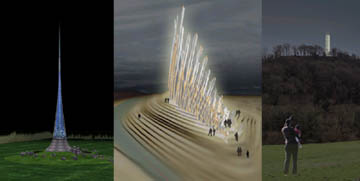
Mid Ocean Studios Inc - Brenda Oakes and CIRIC - Michael W Cook
Picks by Aesthetic Grounds
Simeon Nelson - Infanger and Parker - Openarch
First Aesthetic Grounds Essay
COUPLES INSTALLED IN NEWBIGGIN
I agreed with my first appraisal that the work is mundane and does not substantially honor the working class people of Newbiggin. Henry's emotionally detached figures bring very little to the imagination except for the loneliness of marriage. Compare with Gormley in Liverpool or the lovely stone church floating on the spit.
Both Henry and Gormley owe a note thanks to the Native peoples of the North American continent. The tall totem poles always face the sea. Both the contemporary and traditional figures join together with us glazing at the waves. Viewing the works is secondary to joining the works. (The architect Palladio used this same "joining" in his 16th century theater with Roman figures watching the play with the audience)
First, here is Anthony Gormley from his 2006 temporaty installation in Liverpool, UK.
Gormley in Liverpool. Photo by lupin_pooter on flickr
See the Save the Gormleys Blog
Second, here is Sean Henry's "Couple" in Newbiggin-by-the-Sea, UK
"Couple", Photo by Colin Mitchelson, hojacm on flickr (I emailed Colin due to his photos on Flickr and he graciously took a photo. Thank you so much.)
The historic church in the same field of view as "Couple". Photo by Colin Mitchelson
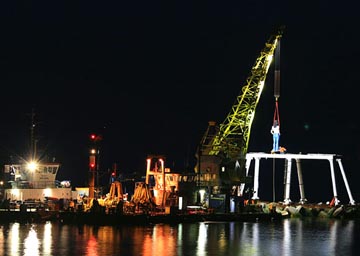
Night installation of "Couple" in August 2007
"Couple" in the studio by Sean Henry
Site Plan on Newbiggin-by-the-Sea. "Couple" on the waterbreak in the center of the cove.
First Aesthetic Grounds Essay
See the Continued Section for Comment from Chelsea Todd of Newbiggin.
As summer is winding down, it's time plan your North American public art and public space travel schedule. Here is my selection.
Burning Man, north of Reno, Nevada, 21 Years in Different Forms
August 27 to September 3, 2007
The giant performance and installation event in the Black Rock desert. Bring your tent and your caffeine to stay up for many nights. (The Burning Man website has an excellent archive.)
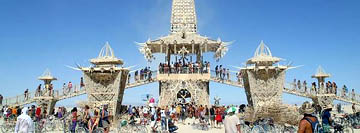
Another amazing temple by David Best and friends. (If you don't know Best's temple for plywood cutouts, search Google Images with "David Best Temple"
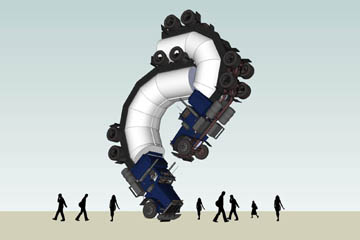
New comer Mike Ross' Big Rig Jig
Nuit Blanche, Year Two, Toronto, Saturday Night, September 29, 2007
One all night party starting at 7:03 PM to sunrise with more than 100 exhibitions, performances, installations, tours and open galleries. 450,000 people attended last year. As opposed to all the lame websites for the major exhibitions in Europe this summer, check on the documentary website from the 2006 Nuit Blanche. Completely comprehensive, on-line archive with photographs and videos. A new model for the arts festivals.
New York City Open House, Year Five, October 5 & 6, 2007
Inspired by the London Open House (Sept 15-16), numerous buildings, parks and offices are open to the public. Special tours and events highlight the qualities of New York City urban design, architecture and public space. In 2006, more than 180 sites were open and 75,000 people participated.
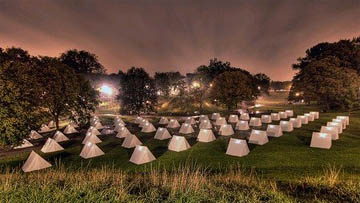
Thom Sokoloski has managed to borrow the southern tip of Roosevelt Island in the East River for a modified installation of his illuminated tents. First introduced in Paris five years ago and then last year in Toronto's Nuit Blanche the work explored the history of mental health. In New York, "The Encampment" will be a "metaphorical archaeological dig into a community's collective memory" with the expression of "of those memories within each of the tents," according to the artist.
Sculpture in Public, Seattle, October 15-17, 2007
The annual Sculpture Magazine conference features tours of the new sculpture park (See the excellent comprehensive story by Clair Enlow in August issue of Landscape Magazine) and most of the other major outdoor public art in the Seattle metro.
Art Basel - Miami, Year Five, December 6 - 9, 2007
The events start throughout the city days before the opening of the Convention Center with its 200 galleries and 40,000 visitors. Big mob party of beautiful people is in the Design District on Thursday night. Many organizations are renting spaces and holding exhibitions and happenings. After a couple of years of "weak" outdoors sculpture in Miami Beach, the lovely Fairchild Botanical Tropical Garden in Coral Gables will present a sculpture exhibition. I hope for better results. Check the websites in October of the schedules.

"Living Room" by Behar and Marquardt in the Miami Design District
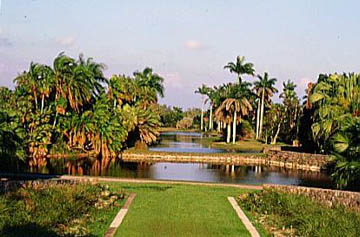
Fairchild Tropical Garden
After my blog on the value of location for public art, I was honored that Cruz-Diez sent me the following essay he wrote in 1996. If you don't know his work, Cruz-Diez is one of the giants of 20th century art in Latin America. He was born in Caracas, Venzuela in 1922. In the 1960s, he began his physichromie series. These paintings, constructions and murals change color and patterns as the viewer moves. On his website, Cruz-Diez has animated the change of one artwork. If you are visiting south Florida, two works are on permanent display at the Boca Raton Museum of Art.
His essay below reminds us of the potential of power of art in our cities and its impact on the psyche of the citizen.
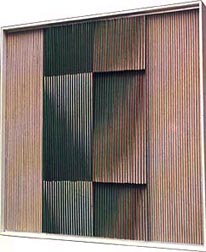
Physichromie No 370, 1967
"THE STREET AS SUPPORT OF ART EVENT"
Toward a poetic of the urban space
Carlos Cruz-Diez
1996
To consider art with regard to architecture and the street is to go through universal history from remote antiquity. It was not until late last century - almost at the advent of the industrial society and of profitability - that the artist was no longer called upon into great architectural projects. Since then the artist turned into easel painting and indoors sculpture.
Art, in many cases served the purpose of spreading out the image of power. It was a required tool of communication for empires and religions. Since most people were illiterate, mass media communication and information were achieved through paintings and sculptures in temples, Palaces and streets. Doctrines and dogmas, with few exceptions, were also promulgated through paintings and sculptures.
Speaking in contemporary terms, to commission an artist for portraying the image of a king was made initially in order to elaborate a "campaign of promotion and information". But that "information " was handled at such an artistic level and with such an efficiency that it was later brought into the field of the "aesthetic" and the sublime. Hence, the utilitarian works of yesterday are still arising our admiration today.
This brings me to believe that the "aesthetic" is nothing more than the result of perfecting a discourse and the evidence of its efficacy.
As kingdoms got to an end and religions managed to codify its communication with people, the utilitarian role of art diverted into what could be considered as "the pure state of art": a fundamental and eternal mechanism of expression, discovery and spiritual communication among men.
It is within this conception that today we confront the artistic creation. In an intimate manner, as in paintings and sculptures of collections, or at an urban monumental level, since our streets and habitats are still valid supports of communication and expression in art.
Since the artist's participation in current society neither meets the same connotations nor complies with the same utilitarian functions as in the past, I believe that his or her performances in public spaces may create unprecedented situations of sublimation, of breaking up conditioning, of spiritual assistance in disrupting gregarious codes and encouraging when bringing back our gone ability to marvel.
For thousands of years, human beings dwelled in dispersed fields and scattered villages. Their collective behavior and notion of freedom were very different from ours. We are learning about a new living situation because urban agglomeration is a relatively recent condition. Our vital space is becoming continually reduced. We must control our gestures and movements in order not to disturb our neighbors.
The only found solution allowing our survival and coexistence within this new way of living, has been constraint and codification which condition man to be submissive, to become more "standard," thus reducing his chance to be different.
In view of this situation, the dweller of the great city has adopted the attitude of an automaton, of an indifferent creature; he does not think, he just acts. In his everyday wandering about, he crosses a pedestrian path or stops on a red light, embracing learned codes, lacking the awareness of the act. He fuses into the multitudes of the city, without having a recollection of his acts.
It is in this difficult scenario - which promises to worsen in the future - where artists might have a protagonist role. Not only to express their plastic discourses, but also to get involved in structuring the spiritual well being of the man of the megalopolis. In an imminent idle society, both art in particular and cultural activities in general will be of outmost importance for social peace.
I believe that the work of art conceived as urban spectacle, could achieve higher importance in today's city than in the past. Through it, our dormant perception would be awaken, so what is neutral, codified, or automatic would be transformed into motivating "situations;" adding to the spiritual legacy of the robotized passer-by.
But a city should not be crowded with works of art. They would become banal objects and loose their fundamental purpose. Installing them on the streets should be the outcome of the reflection of a team integrated by the artist, the town planner, the architect, the engineer, the landscape architect, artisans, technicians, and promoters. Based upon the concepts outlined above, they should orchestrate the most adequate solutions for the location, scale and atmosphere of a given work.
Art on the street could "animate further readings," leading toward different levels of information, knowledge and the pleasure to "see," not to look.
On the other hand, the streets are also ideal supports of non-institutionalized ephemeral work. The artist can create in the passer-by, the impact of situations of fondness, surprise, amusement, and rupture by exciting his or her imagination.
In the past, one single person, "the artist," conceived and accomplished everything. Our parceling up of knowledge has brought the artist's action to be divided into diverse professions and specialties.
In a project, the artist should be convened as part of the creator team and not be called when everything has been decided, for "decorating" or mending a deficiently conceived solution of space.
I say this because, currently, the artist is never expected to be included in a team assigned to conceive environmental and urban projects. The artist's irreverent condition in front of "dogmas," could generate unprecedented solutions. He could inspire the imagination of a working team that many times becomes embedded in professional routines.
Urban environment could be deteriorated even further if the reflections exposed above are not taken into consideration. Works should not be installed without first considering the location, space, scale and type of work.
In my pursuit, I have tried to encounter non-traditional solutions to the perception of the chromatic world and plastic space. As a searcher, I have believed - since early age - that art is communication and that the artist should provide works, not only to purvey museums and collections, but also permeate into everything that touches the collectivity.
I think that a work of art integrated into the community or the habitat, should engender unprecedented events in constant mutation. This is a way to extend the "call for its reading in time" and to distinguish it from the utilitarian object of the street furniture.
The works I make for the urban environment and the habitat are conceived as plastic discourses generated in time and space, while creating "situations" and "chromatic events," and modifying the dialectic between the spectator and the work. They are not "referential discourses," as in the Gothic, the Renaissance or the Mexican muralists, but they profess a distinct start point in which real time and space substitute referred or transposed ones. They are, indeed, "the supports of an event" which changes end evolves, according to the path of light and to the spectator's angle of view and distance.
They constitute "realities" and "autonomous" situations. "Realities," inasmuch as they are events evolving from time and space, and "autonomous" situations, since they do not depend on the anecdotist discourse that the spectator expects to meet in art. A different learning relationship thus is established. Spectators discover their ability to create or to break down color by their own perceptive means. They discover the "making of the color," emerging and dissolving before their eyes.
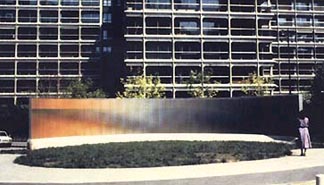
Physichromie Double Face, Paris, 1976, 18 meters by 3 meters
Aesthetic Grounds YouTube Site
Selected Videos on Public Art and Public Space
Best of Public Art Websites
1. Muncipal Website: Indianapolis, USA
2. Administration and Case Studies: Public Art Online, UK
3. Photos of USA Projects: Public Art Network, USA
4. Policy for Art in Buildings: Queensland, Australia
5. Sample Contracts, Call to Artists and Other Documents: PAN, USA
6. Sample MP3 Walking Tours: Lower Manhattan Cultural Council, USA
7. Socio-Political Critique through Public Art: Transform, Europe
8. Artist: Pete Codling, UK
9. Artist Registry: 4Culture, USA
10. Community and Public Art: Community Arts
11. Urban Inventions: Wooster Collective
12. Publishing: Black Dog
Best of Public Space Websites
1. Essays: Jane Holtz Kay
2. Functional Criticism: Project for Public Spaces
3. USA Case Studies: Bruner Foundation
4. Lots of Ideas from DC: Richard Layman
Best of Architecture Websites
1. Essays: Hugh Pearman, UK
2. Selected Architecture Images: Eyecandy
3. Essays: James Russell, USA
Perhaps a division exists among the designers and artists of physical space in the city. All them wish to bring renewed energy to the person in space. Physically, the artists could create a perfect moment of relaxations under a tree and the near the fountain on a hot day. Mentally, the artists could spark contemplation, a laugh or a conversation by adding images or text that interaction with the attributes of the space or culture.
Another group of people has these goals, but also wished to bring life to space itself. Not more human activity as this phase "bring life to a place" usually means, but rather animating the place itself. These artists feel a psychological (and perhaps physical) transformation described metaphorically as "energy".
Since storytelling began, poets have described this psychological state with its sense of intimate connection to the land, buildings, trees, etc that are present in that location. Professionally, the best gardeners, landscape architects and architects know and implement spatial transformation to heighten this feeling of connection with an animated place. Typically, artists have so little control of a space that their maximum impact might be compared to a beautiful tree - only one element, but an essential element. A tiny list of artists that have specialized include Robert Smithson, Dan Graham, David Hammons, Buster Simpson and Michael Singer. Many other artists strive, but don't 100% succeed in reinforcing or modifying the intimate connection.
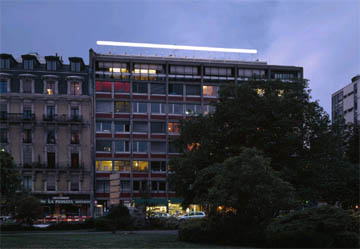
Breath by Jerome Leuba. Photo: Serge Fruehauf, 2007
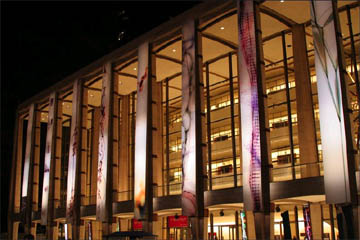
Breath by Open Ended Group. Photo by Peter Cunningham
Two artists this summer named their new installations "Breath". Even more than a beating heart, breathing is the visible proof of life. To feel the intimate connection of poets, we humans look for the signs of life - that is change. We look for scars on the rocks, the broken branch and the pooling rainwater. We look for tropism where things change because their action to connect or avoid something else. We look for rhythm in the repetition of form and actions like a line of ants or a breath.
Both artists this summer used the changing bright to dull of electrical light intensity to simulate breathing. Both artists attached the long strip that light up on the façade of a building in a public space. Both artists assumed the traveler would stop and watch the coming and going of light. The artists have entirely different objectives for the space.
Jerome Leuba in Geneva strives to animate while the Open Ended Group creates a visual performance of animation. In the dark above the park, Leuba's horizontal neon tube slowly appears and disappears, mimicking inhale and exhale. Open Ended never folds into the dark due to the ambient light of Lincoln Center. The slow on and off spot lights shining on the vertical banners mounted to the concert hall columns and fade before returning to brightness through an arbitrary but music generated pattern. Leuba is silent, singular and pure. Open Ended is ever-changing, highly-designed, loosely-decorated and audible.
Open Ended writes, "as if Avery Fisher Hall were breathing with music, with light, and with thought". The old "as if". The difference between metaphor and simile. Open Ended does not contribute to the animation of the plaza, but converts Avery Fisher into a music machine. It is a live action symbol reminding us of ourselves through matching our biology and history of music generated via the rhythm of that biology - breathing in chorus.
Whether Leuba sculpture works or not, I cannot know without a trip to Switzerland. But Leuba wants the metaphor. The work and its space actually breathe. Like a flower blooming through a crack in cliff, its presence shifts the traveler's perspective from utilization to listening. The imagination makes the psychological shift to knowing the space as alive through the tiny breath.
Breath in Geneva by Jerome Leuba
Breath at Lincoln Center by Open Ended Group members Marc Downie and Paul Kaiser
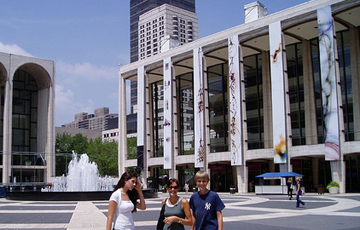
Breath at Lincoln Center on Avery Fisher Hall
Breath in Geneva. Photo: Serge Fruehauf, 2007
Organizational Links
Lincoln Center Breath Website
The Geneva public project NEON
To add another little touch, I found this neon drawing of a brainwave pattern on the top of British hospital (I have lost all information about the work.) Clearly just a symbol. But the work is a courageous act for hospital since the brainwave is now the legal definition of human life or death. Think about it.
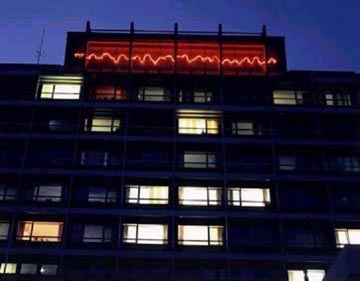
Unknown Artist. Brainwave at top of hospital in UK
LEAP and SLOW DANCING
At Lincoln Center in July, David Michalek presented his scientific, commercially-styled video on three outdoor screens on Alice Tully Hall. The critical response reveals the disconnect between the disciplines in the arts. Michalek's website links to every article - all by dance critics. None of the critics seem to have any knowledge of the history of exterior projections or film/video installations.
I doubt this is Michalek's method, but if an artist wishes to be well-known, then take slick pictures of well-known people and show them only to people unfamiliar with the history of media. I like looking at HD video of colorful insects on the Discovery Channel as much as the next guy and I imagine the Michalek's slow motion is lovely, but such a high profile visual event should have some knowledgeable writing. Each critical response is exactly the same. Intro paragraph, quotes from the press release on the process and a desription of the writer's favorite dancer.
Just to name some obvious comparisons, some writers should have recalled Doug Aitken's Sleepwalkers at the MOMA last winter. Maybe Jaume Plensa's giant slow faces in Chicago's Millennium Park. If they follow public art, they would have noted LEAP by Chris Doyle, seven years ago at Columbus Circle a few blocks away. Not beautiful dancers in the commercial studio, but just common New Yorker's jumping in slow motion. Rather than using the Lincoln Center plaza like thousands of summer movies shows in amphitheaters and parking lots across the world, Doyle's leapers struggled to bring joy to the controlled chaos of the giant round-a-bout.
If you missed New York, the "west coast premiere" of Slow Dancing is in September in LA. But driving back you home, catch the opening of Doyle's new work in Kansas City titled "The Moons" with jumpers on trampolines. October 9, 2007 at the new Sprint Center.
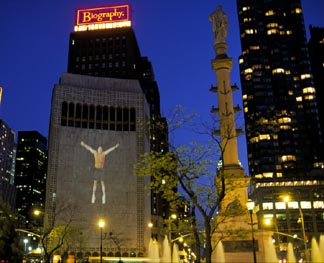
April 27-30, 2000
At 2 Columbus Circle, New York, NY
From Creative Time website:
A celebration of hope and pure pleasure, Leap was a video project documenting various New Yorkers from all five boroughs jumping skyward. Using the subway infrastructure as a map for the project, Chris Doyle approached community groups at the end points of all the subway lines that stop in Columbus Circle in order to solicit participants for his project. In August and September of 1999 video shoots took place in each of these neighborhoods. At these shoots, four hundred and twenty New York residents and visitors were documented jumping as high as they could against a black backdrop. Edited and slowed down, the footage was projected onto a sixty-foot building in Columbus Circle.
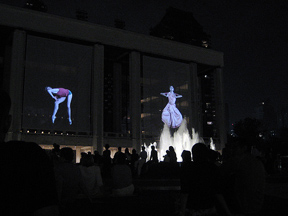
Slow Dancing Video by David Michalek at Lincoln Center, July, 2006
From The Music Center Website
Beginning September 18, The Music Center will present the West Coast premiere of David Michalek's Slow Dancing, an outdoor installation of larger-than-life, hyper-slow-motion video portraits of extraordinary dance artists and choreographers from around the world. High-speed - 1,000 frames per second -- high-definition cameras recorded sequences with major figures that include Trisha Brown, Bill T. Jones, famed krumper Christopher "Lil' C" Toler, William Forsythe, Shen Wei, Wendy Whelan, Eiko and Koma, Allegra Kent, and Judith Jamison as well as dancers who are considered national treasures from Southeast Asia, the Pacific Rim and Africa. This combination of cutting-edge imaging technology and dance artistry gives viewers a unique glimpse into a secret world. This is an evening event taking place daily on the Music Center Plaza September 18-26, and is free to the public. Slow Dancing was commissioned by the Music CenterEach subject's movement (approximately 5 seconds) was shot on a specially constructed set with a high-speed, high-definition camera recording at 1,000 frames per second. The result is approximately 10-minutes of extreme slow movement--a motion portrait in which the dancer's unique artistic expression and technique are revealed as never before. According to The New York Sun, "The result is movement so slow that if you glance at the video, your eye initially perceives a photograph. But look at the image longer and it moves at a rate that allows you to watch the minutia of each step breath by breath... The slowness of the moving image allows us to see the steps with detail that is impossible to see in real time."
After my rant on the failure of public art to find a home in valuable, visible places, the City of Nashville has the guts to hire Alice Aycock with its first artwork and site it on the Cumberland River. Not any location, but at the terminus of an important historic street, under the shadow of the Titans football stadium and in plain view of every river boat and corporate window in downtown Nashville.
Urbanisticly, the work succeeds from many places and helps make the connection between the high city and industrial flood plain. On axis with Broadway, the broken red steel crescents form a bull's eye with a swilling double top-like thing in the middle - a clear graphic artwork from the material of industry. From the riverbank and bridges, the work is a mess of metal that vertically defines the edge of bank and appears invisibly stopped from moving toward the high city - a psychological movement of rejection. From the river walk looking up through the sculpture, the work beautifies the memory of lightweight steel structures of warehouses and bridges.
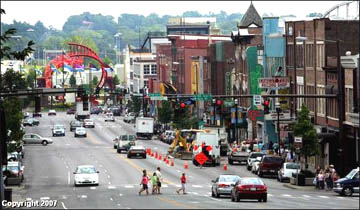
100 x 100 foot sculpture fills the Broadway view. Photo Larry McCormick / The Tennessean
More than Aycock's other works, I think the sculpture will attract amateur photographers - an essential element of the successful public art. Flickr pictures show the interest in detailed "artistic" photos through the open struts.
I don't know if it is a comment on the polite quality of southern newspapers or the work itself, but an intelligent debate has been sponsored and supported by the Tennessean. On Saturday, August 4th, the Tennessean Newspaper Editorial Board supported the first major public artwork in Nashville. The paper also ran reader opinions, a public art board member and a libertarian who argued that government sponsorship of art is bad for the art. In July, the Tennessean ran a comprehensive news story with good photos.
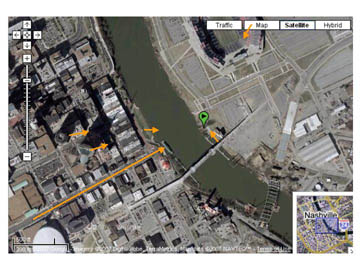
Excellent visual civic location. On axis with Broadway. Tower views. Stadium Views. River Views.
Metro Nashville Arts Commission is the agency managing the project.
On line at my day job google site is a powerpoint presentation on "What is an Icon?" At the end of the images, you can see the four of the competition entries from Aycock, Carpenter, Sayre and Openheim.
Since I coordinated a contest for a mural in the freshman architecture studio at Georgia Tech in 1976, I have been involved in public art and public space. After 30 years, how did the public art establishment get cornered into public bathrooms and terrazo floors with their limited public art dollars? It's time for public art to be front and center of new spaces and buildings again.
A few years ago at the Polk Museum of Art in Lakeland, Florida, I met artist John Henry. (Lakeland should be on every cultural tourist itinerary for the Frank Lloyd Wright campus at Southern Florida College, the annual Lemon Street sculpture display and the general beauty by which the lakes are integrated with the city.) Henry was joking with a friend about the "no-see-um" art. I always wondered what the "plop art" artists called integrated artworks. "No-see-um" (slang for tiny, blood sucking flies) has not caught on, but it is at least as insulting as "plop".
In my days in Seattle, I worked as hard as any curator or arts administrator to merge art into daily life and to enhance the built stuff. But in Florida I have felt the desire of sincere, creative citizens to SEE the art. They want the art in the front of the building, at the busiest intersection or on the crowded pedestrian plaza. They want the work to be framed with landscaping or architecture.
It is time to add a new method to our systems of commissioning new work. In certain projects, pre-plan the artwork as the visual priority. Imagine the RFQ for the A&E: "Artists will be selected to create works for the project. These artworks will be the main visual focus on any exterior plazas, main façade and/or lobbies. Site planning, architecture, landscape and lighting throughout those areas will be designed to reinforce the priority of the artwork."
Or perhaps the artist is selected before the A&E firm. In addition to the A&E contract, the building program would include the following: " The public art program selected an artist based on past work to design an artwork for a façade, plaza or whatever. The artwork will be the main visual focus on the façade, plaza or whatever. The design of all aspects of that area of the facility will assist in making the artwork the pride of the community."
A value exists regarding the location of the artwork. All the "generals on horses" have the best places in the plan of the city and punctuate the roadway vistas. The fountains in Rome animate the plaza. The Virgin Mary hovers above the alter and on axis with everything in the basilica.
An artwork in a corner may have the advantage of intimate contact, but the location and scale may imply its lack of importance to the institution. A classic example is the glowing mosaic murals by Dixie Friend Gay in the passage between the parking garages at the George Bush Houston airport. $250,000 spent in lonely corridor without any substantial place value. Despite the immense quality of the work, the choice of place demotes the work.
Below are a few modern and postmodern examples of artworks prioritized by the owner and architect. No tricky photography is necessary to make the artwork look important. The building and site want the artwork.
It's simple to know when the priority occurs. Step back to a location where you can see the artwork and building as a normal traveler would approach space. Does your eye go to work? Does some feature interfere with the artwork? If the artwork went away, would the space or building be empty? Would the architect need to design a substitute?
Priority for artwork in the valuable places should only remain one possibility, but one that needs to return to our cities
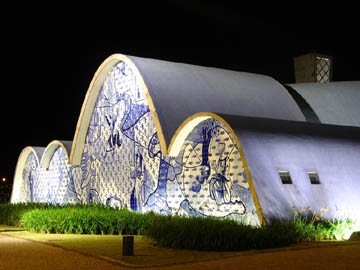
Church of Saint Francis, Brazil, 1943, Architect Oscar Niemeyer, Artist Cândido Portinari
Bacardi Building, Miami, 1963. Architect Enrique Gutierrez. Artist Francisco Brennand Photo Joe Kunkel
Tour Stratos, Valencia, Venzuela, 1990. Architect Yañez and Láncara. Artist Carlos Cruz-Diez
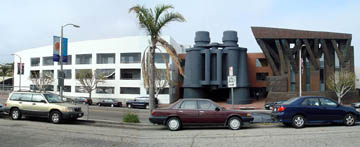
Chait Day Building, Los Angeles, 1991. Architect Frank Gehry. Artist Claus Oldenburg
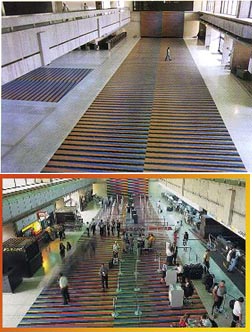
To prove I am NOT against floors, here is Carlos Cruz-Diez at the Caracas Airport, 1974. Architect Montemayor and Sully
Blogroll
Aesthetic Grounds YouTube Site
Selected Videos on Public Art and Public Space
Best of Public Art Websites
1. Muncipal Website: Indianapolis, USA
2. Administration and Case Studies: Public Art Online, UK
3. Photos of USA Projects: Public Art Network, USA
4. Policy for Art in Buildings: Queensland, Australia
5. Sample Contracts, Call to Artists and Other Documents: PAN, USA
6. Sample MP3 Walking Tours: Lower Manhattan Cultural Council, USA
7. Socio-Political Critique through Public Art: Transform, Europe
8. Artist: Pete Codling, UK
9. Artist Registry: 4Culture, USA
10. Community and Public Art: Community Arts
11. Urban Inventions: Wooster Collective
12. Publishing: Black Dog
Best of Public Space Websites
1. Essays: Jane Holtz Kay
2. Functional Criticism: Project for Public Spaces
3. USA Case Studies: Bruner Foundation
4. Lots of Ideas from DC: Richard Layman
Best of Architecture Websites
1. Essays: Hugh Pearman, UK
2. Selected Architecture Images: Eyecandy
3. Essays: James Russell, USA
AJ Ads
AJ Blogs
AJBlogCentral | rssculture
Terry Teachout on the arts in New York City
Andrew Taylor on the business of arts & culture
rock culture approximately
Laura Collins-Hughes on arts, culture and coverage
Richard Kessler on arts education
Douglas McLennan's blog
Dalouge Smith advocates for the Arts
Art from the American Outback
For immediate release: the arts are marketable
No genre is the new genre
David Jays on theatre and dance
Paul Levy measures the Angles
Judith H. Dobrzynski on Culture
John Rockwell on the arts
Jan Herman - arts, media & culture with 'tude
dance
Apollinaire Scherr talks about dance
Tobi Tobias on dance et al...
jazz
Howard Mandel's freelance Urban Improvisation
Focus on New Orleans. Jazz and Other Sounds
Doug Ramsey on Jazz and other matters...
media
Jeff Weinstein's Cultural Mixology
Martha Bayles on Film...
classical music
Fresh ideas on building arts communities
Greg Sandow performs a book-in-progress
Exploring Orchestras w/ Henry Fogel
Harvey Sachs on music, and various digressions
Bruce Brubaker on all things Piano
Kyle Gann on music after the fact
Greg Sandow on the future of Classical Music
Norman Lebrecht on Shifting Sound Worlds
publishing
Jerome Weeks on Books
Scott McLemee on books, ideas & trash-culture ephemera
theatre
Wendy Rosenfield: covering drama, onstage and off
Chloe Veltman on how culture will save the world
visual
Public Art, Public Space
Regina Hackett takes her Art To Go
John Perreault's art diary
Lee Rosenbaum's Cultural Commentary
Tyler Green's modern & contemporary art blog
